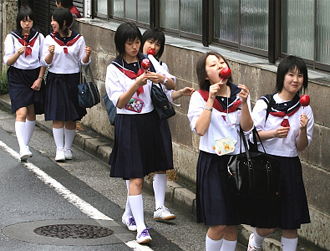Weight of Japan's Girls Decline for First Time
By wchung | 05 Aug, 2025
Japan’s children are starting to diet at a younger age, producing a decline in the average weight of girls in all age groups from 5 to 17 in the 2011 school year. This was the first such decline since the government began surveys in the 1948 school year, said the Education Ministry Thursday.
The average weight of boys also fell in most age groups, according to the Ministry’s preliminary report on trends in children’s physical condition. Boys aged 17 was the only group in which the percentage of overweight children did not decline.
The average weight of Japanese children peaked between the school years of 1998 and 2003 following a sustained period of growth since the end of World War II. More recently the average weight has shown a marked downward trend.
The average weight of girls aged 16 slipped 0.3 kilograms (0.7 pounds) to 52.4 kg (115.3 pounds). In other age groups the drop was a smaller 0.1 to 0.2 kg (0.04 to 0.08 pounds), according to data obtained from April to June from 650,000 children in schools across Japan. The data did not include Iwate, Miyagi and Fukushima prefectures due to the March 11 earthquake and tsunami.
Among girls aged 17 the percentage of overweight girls declined in urban centers like Tokyo, Kanagawa and Hyogo prefectures but rose in more rural areas like Hokkaido, Tohoku and Kyushu, suggesting greater weight consciousness in trendier regions.
Among boys aged 11 the average weight fell 0.4 kg (1 pound) to 38.0 kg (83.6 pounds). The average weight also fell for all other ages of boys except those aged 7 and 17, who remained unchanged.
The data supports the conclusion that children have begun to diet at an earlier age, said Seiji Osawa, professor in behavioral epidemiology at Otsuma Women’s University.
“Children who are underweight when they are growing risk impairing their athletic performance and harming their health,” he cautioned. “We have to put a brake on their tendency to overly value the idea that being thin is beautiful.”
Since the end of World War II Japan’s children have been steadily adopting richer western foods like hamburger, ice cream and fried chicken to their daily diets. While the westernized diet has produced more overweight people, it has also helped ease the malnutrition commonplace among Japanese whose traditional diets lack sufficient protein, calcium and various vitamins and minerals commonly found in diets containing more fresh vegetables and dairy products. Japan’s average height had risen to 5-7 1/2 and 5-2 for men and women, respectively, by 2006 — an increase of about 3 inches since World War II.

Japanese children have begun to decline in average weight for the first time since 1948, suggesting a trend toward earlier dieting.
Asian American Success Stories
- The 130 Most Inspiring Asian Americans of All Time
- 12 Most Brilliant Asian Americans
- Greatest Asian American War Heroes
- Asian American Digital Pioneers
- New Asian American Imagemakers
- Asian American Innovators
- The 20 Most Inspiring Asian Sports Stars
- 5 Most Daring Asian Americans
- Surprising Superstars
- TV’s Hottest Asians
- 100 Greatest Asian American Entrepreneurs
- Asian American Wonder Women
- Greatest Asian American Rags-to-Riches Stories
- Notable Asian American Professionals

